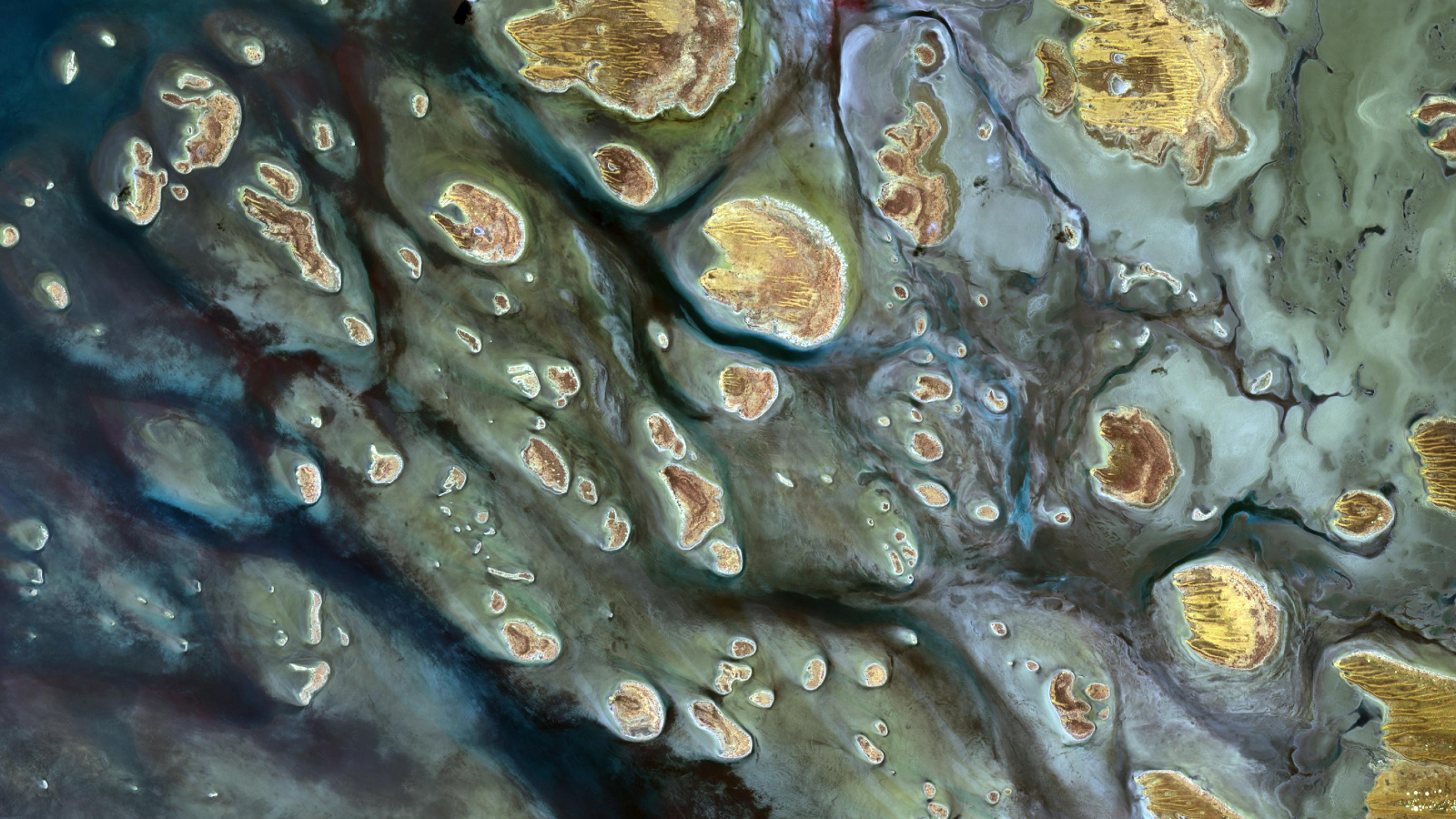Earth from space: Giant 'phantom lake' dotted with stripy gold islands shimmers in Australian outback
A 2010 satellite image shows dozens of golden islands covered with strange parallel lines shining among the shallow waters of a massive, half-full ephemeral lake in Australia's Great Sandy Desert.

Where is it? Lake Mackay, Australia [-22.40211170, 128.99460842]
What's in the photo? Dozens of stripy golden islands in shallow water
Which satellite took the photo? NASA Terra
When was it taken? Sept. 19, 2010
This satellite snap shows dozens of stripy, golden islands shimmering in the shallow waters of a giant temporary lake that provides a refuge for wildlife in one of Australia's most extreme environments.
Lake Mackay, also known by local Indigenous people as Wilkinkarra, is one of Australia's many ephemeral salt lakes — temporary bodies of water that appear only after heavy rain and flooding. It is located along the border between Western Australia and the Northern Territory in the Great Sandy Desert, which covers around 110,000 square miles (285,000 square kilometers) and is the second-largest desert in the Australian outback.
When the lake is full, it covers around 1,800 square miles (4,700 square km), making it Australia's fourth-largest lake behind Kati Thanda-Lake Eyre, Lake Torrens and Lake Gairdner, which are all also ephemeral, according to Australian Geographic. It becomes salty due to a high concentration of minerals in the lake bed.
The lake's depth varies, but when it is full, its waters are likely between 20 inches (50 centimeters) and "several meters" deep, according to NASA's Earth Observatory. Depending on how much rainwater ends up in the basin, Lake Mackay can persist for up to six months at a time.
In this image, the lake is slightly over half full. Dozens of golden islands stand out in a sea of blues and greens: The darker patches stretching between the chunks of land are standing water puddled in the lake's deepest points, while the lighter hues are desert vegetation, algae or moist soils, according to the Earth Observatory.
Related: See all the best images of Earth from space

The largest islands in Lake Mackay are covered with strange parallel lines running from east to west. These lines are permanent dunes cut into the ground over millions of years by wind erosion. They mirror similar ridges that cover the Great Sandy Desert and the surrounding areas in the same direction.
Sign up for the Live Science daily newsletter now
Get the world’s most fascinating discoveries delivered straight to your inbox.
Similar ephemeral lakes form in other deserts across the globe, including Badwater Basin in California's Death Valley National Park and sometimes across the Sahara Desert after extreme rainfall. These lakes often provide a temporary haven for wildlife that spend long periods in some of the harshest environments on Earth, and Lake Mackay is no exception: It hosts more than 90 species of birds, reptiles and mammals, including rabbits and occasionally camels, which are both non-native to Australia, according to a survey carried out by the Environmental Protection Agency of Western Australia.
The ephemeral lake was also home to a now-extinct species of marsupial known as the Lake Mackay hare-wallaby (Lagorchestes asomatus). Not much is known about this species because only one complete skull has ever been found. However, it likely lived until relatively recently because it is mentioned in records kept by Aboriginal Australians.
Lake Mackay also inspired the name for a giant lake on Saturn's largest moon Titan, named Mackay Lacus, which is around 110 miles (180 km) wide and is made up of a mix of liquid methane and liquid ethane.

Harry is a U.K.-based senior staff writer at Live Science. He studied marine biology at the University of Exeter before training to become a journalist. He covers a wide range of topics including space exploration, planetary science, space weather, climate change, animal behavior and paleontology. His recent work on the solar maximum won "best space submission" at the 2024 Aerospace Media Awards and was shortlisted in the "top scoop" category at the NCTJ Awards for Excellence in 2023. He also writes Live Science's weekly Earth from space series.









